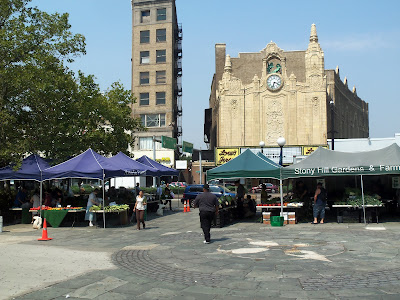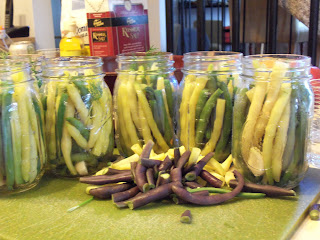Hi Friends,
It’s mid-May and I’m looking forward to a new season of preserving
and pickling. I have new challenges and new goals.
The biggest challenge
is to locate top quality fresh produce in Jersey City and the surrounding area
including New York and Pennsylvania. The second is to maximize canning in my
(not too big) apartment kitchen. The third is to be cost-conscious. It’s not as
expensive a hobby as golf, but there is a large $ input for a little jar of output.
My first goal is
to win a ribbon for my jarred products in a county fair this summer. My second
goal is to make jams as favors for a bridal shower, baby shower or birthday
party. That leads into my third goal, to create a cute label for my jars. And last
but not least: Try new things: like freezer pickles or preserved lemons.
I promise to continue my education in preserving by reading
all the information I can on the topic, and attending classes or workshops if
available. Maybe one day, I can teach how to put up food.
In preparation for this second “Summer of Jam and Pickles”, I did a few things: bought new equipment,
organized my books, made a list of the farmers markets in Jersey City, and took
an inventory of the jams I had on hand at the present time.
I had packed up my canning jars and lids, the pickle crock
and the large earthenware bowls, the kettle, strainers, tongs etc and put them
in storage. I didn’t think I’d have room here. When I had made the marmalade
last winter, I realized I needed this equipment here in the apartment. So I
bought a box of canning utensils, and a steam canner. This is not a pressure
canner, but an alternative to the boiling water bath process. In
my small kitchen, it takes up less space, uses less water, and gives me an extra pot
to use as a sterilizer, and as intended to heat the jars and the contents and
make a seal. For those of you who love to shop on-line or who don’t have a
friendly Ace hardware store in the neighborhood, try amazon.com for canning
supplies.
This is my collection of books on making jams, etc, and
pickles and the like. It comprises the following, and hopefully, I can add new
ones to it. Recommendations are always welcome.
The Blue Book, Guide to Home Canning and Freezing, by
the Ball Company.
The Heinz Guide to Successful Pickling, by H. J. Heinz
Co. (1976)
Blue Ribbon Preserves, by Linda J. Amendt,
The Complete Book of Small Batch Preserving, by Ellie
Topp and Margaret Howard
Canning for a New Generation, by Liana Krissoff
The Joy of Pickling by Linda Ziedrich
Pickles and Relishes by Andrea Chesman
Canning – 120 ways to savor the season year round, a special
interest publication by Better Homes and Gardens.
And the last really oldie but goodie:
Complete Guide to Home Canning, Preserving, and Freezing
by the U.S. Dept of Agriculture (1973)
Jersey City has a Farmer’s Market open somewhere in the
city, seven days a week. Can I get to all of them this summer? Downtown F.M. –
Mondays and Thursdays
Harvest Square F.M. – Tuesdays
Newport Center F.M. – Tuesdays
Journal Square F.M. – Wednesdays and Fridays
Hamilton Park F.M. – Wednesdays
Van Vorst Park F.M. – Saturdays
Riverview F.M. – Sundays
Hoboken Downtown F.M.
– Tuesdays
Hoboken Uptown F.M. – Thursdays
And I hope to head out to some pick-your-own farms, too. I’m
reminded to be “green” and bring my own shopping tote to the markets. My
daughter is crocheting a string bag, and setting a good example with her C.S.A.
share. The above list is for me to refer to so that I visit and describe every one, hopefully bringing back some unique fresh produce to turn into a pickle or jam.
The inventory from 2011 (includes marmalade from Jan/Feb
2012). Pushing aside the hangers in the closet, I’ve discovered: Jam: red plum
three 4oz, spiced blueberry, strawberry-marsala, lemon-thyme four 4oz,
strawberry- rhubarb six 4oz, pumpkin, carrot, blackberry,
Preserve/Marmalade: cherry preserve, Earl Grey peach seven
4oz, citrus marmalade, meyer lemon marmalade, pineapple marmalade, four 4oz,
cranberry marmalade, tangerine grapefruit marmalade, sliced peach preserve,
Jelly: apple-mint six
4oz, grape, peach-jalapeno two 6z and three 4oz,
Pickles: in pints: 4 dills, 3 bread and butters, 2 sweet
icicles
Let me know if you are interested in taking some.
There are a couple of county fairs within an hour's drive for
me. The Middlesex and the Warren county fairs are in early August and the registration forms have to be sent in by mid-July. Lots of work to do in June and July!!! Each has posted the categories of jarred food for
competition, the application forms and the rules. Just imagine: Joan’s award-winning jams - tomato marmalade - pickled vegetables. I'll let you in on the process and the fun. Hope we are celebrating a ribbon later this summer.
 However, the first attempt was rather a disaster... in trying to make a grape jelly with homegrown grapes generously given me by my friend, with the plan to return the grapes in the form of sparkling sweet/tart white grape jelly. In my enthusiasm to use the pot, I disregarded all the guidelines that I had learned in the last few years. Fruit too green, not enough sugar, not adding pectin for jelly, cooking way too long, not reaching the jel point - that just about covers everything about preserves. Here is how it turned out. I didn't blame the pot ( just at first) - they were all my mistakes.
However, the first attempt was rather a disaster... in trying to make a grape jelly with homegrown grapes generously given me by my friend, with the plan to return the grapes in the form of sparkling sweet/tart white grape jelly. In my enthusiasm to use the pot, I disregarded all the guidelines that I had learned in the last few years. Fruit too green, not enough sugar, not adding pectin for jelly, cooking way too long, not reaching the jel point - that just about covers everything about preserves. Here is how it turned out. I didn't blame the pot ( just at first) - they were all my mistakes.







.JPG)










































